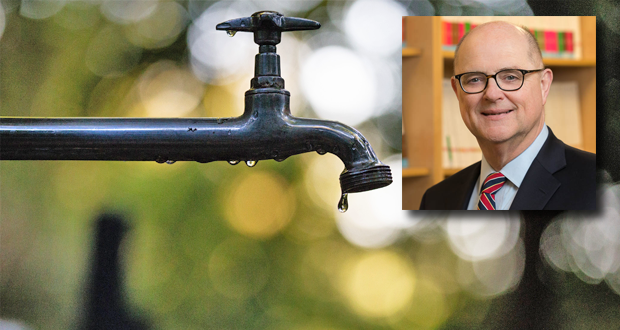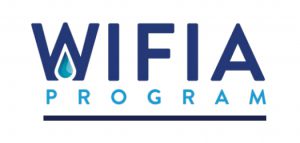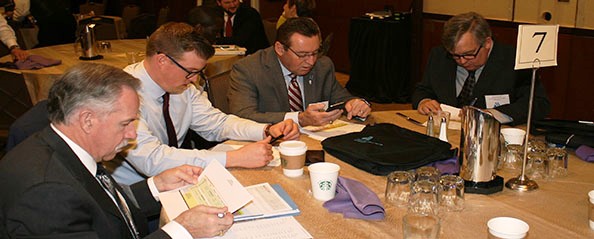Advocating for a Better Legislative Flow

Water is essential to life, and for the American Water Works Association, there may be no function more essential to its mission of “providing solutions to effectively manage water, the world’s most important resource” than advocating for clean, safe drinking water. Since its beginning in 1881, AWWA has grown to become the largest association of water supply professionals in the world with 50,000 members that represent 3,900 utilities that provide about 80 percent of the United States’ drinking water.
G. Tracy Mehan III, AWWA’s executive director for government affairs, leads a staff of eight at the association’s Washington, D.C., office. His experience working in legislative affairs for a private firm before running the Office of Water at the Environmental Protection Agency (EPA) under President George W. Bush has informed his role as an association-based advocate. Mehan details below how his department advocates for safer, more durable drinking water systems.
Association Adviser: Tell us about your role with AWWA.

G. Tracy Mehan III: I’m the executive director for government affairs with the American Water Works Association. Eight of us run AWWA’s Washington office. AWWA’s headquarters are located in Denver, where 140 of our colleagues are doing quite a bit of work focusing on the effective management of water. Here in D.C., we focus on the Hill, on legislation about infrastructure and financing as it relates to safe and sustainable drinking water. We work with regulatory agencies, the EPA and the Department of Homeland Security (DHS) to achieve our goal of educating U.S. lawmakers about critical issues facing the water community.
Currently, we’re working to obtain continued and robust funding for the Water Infrastructure Finance and Innovation Act (WIFIA). This is a new loan program that allows states and municipalities to borrow money at treasury rates, which are traditionally extremely low, for water infrastructure improvement, repair or expansion projects. Such projects could include improved water delivery systems, fixes to water distribution problems, equipment replacement or expanded water distribution systems.
 Very low default rate of loans made to water and wastewater utilities mean that every dollar appropriated to WIFIA can allow for an estimated leverage ratio of 60 to 1 or more. We’re trying to show Congress that water infrastructure improvements are necessary, and that appropriating the full $45 million we’re asking for could turn into billions in project assistance to states – a very good return on investment. But with all the recent talk of tax reform, we’re concerned about the protection and future of municipal bond financing. So we keep advocating for smart legislation because our country’s water infrastructure desperately needs attention.
Very low default rate of loans made to water and wastewater utilities mean that every dollar appropriated to WIFIA can allow for an estimated leverage ratio of 60 to 1 or more. We’re trying to show Congress that water infrastructure improvements are necessary, and that appropriating the full $45 million we’re asking for could turn into billions in project assistance to states – a very good return on investment. But with all the recent talk of tax reform, we’re concerned about the protection and future of municipal bond financing. So we keep advocating for smart legislation because our country’s water infrastructure desperately needs attention.
Each state works with the EPA to set up State Revolving Funds (SRFs), low-interest loan fund programs that raise money for water infrastructure projects. As consumers benefit from and pay for these projects through their water usage, and as towns and cities are able to pay back the loans, the EPA and states are able to sustain their revolving loan funds and finance other water projects. My office works to maintain or increase federal financial support for SRFs.
AA: What regulatory issues are big for AWWA?
GTM: On the regulatory side, our main items of concern are consideration/revisions to lead and copper rules, and also perchlorates rules. These minerals and chemicals in water are regulated by the EPA.
Lead in water is a big issue, especially in the wake of the tragedy in Flint, Mich. The main way we expose our drinking water to lead is through corrosion of pipes. We’ve put out recommendations for managing and replacing old lead pipes. AWWA has also looked at ways to replace lines on public property to solve this issue, but recent research has shown that to adequately address the problem, you must replace private lines, too. So we’ve spent a lot of time working with other stakeholders to remove lead service lines not just on public property but on private property as well. That’s a big effort, a new approach to managing risk of lead exposure because by definition, public utilities or the government cannot control what happens with privately owned pipes. Updating them – collaborating with private owners – takes a lot of discussion. Utilities don’t control private lines and in some states are prohibited by law from replacing private lines. So we have to find collaborative ways of solving the problem of lead leaching into drinking water.
To facilitate that, AWWA is sponsoring a collaboration called the Lead Service Line Replacement Collaborative with the APHA, the Blue-Green Alliance, the Children’s Health Network and Clean Water Action among other groups. Our goal is to develop models of how a community, in partnership with utilities and private homeowners, can remove lead piping for the benefit of all who need safe drinking water.
AA: How has your EPA experience helped you in your position at AWWA?
GTM: Working on the inside [at the EPA] was helpful to understand the dynamics of regulating the water industry and the constraints of managing such an effort. Now that I’m on the outside [with AWWA], I understand what the regulatory interests and concerns are from utilities and how to best communicate those to the EPA insiders. Most of what we do is collaborative with EPA. There is a lot of mutual interaction in trying to determine the best outcome for public health and for the people who have to feasibly implement new or modified regulations at utilities.
AA: Are you working on any new initiatives?
GTM: We’re spending more time trying to understand the Farm Bill and United States Department of Agriculture (USDA) conservation programs. Many water issues we face, especially nutrient over-enrichment and harmful algal blooms are the result of things going on in landscape and agriculture. We’d like to develop a closer partnership with the USDA and teach our utilities about what opportunities there are to collaborate with USDA programs, not only in Washington but in their states.
We’re also looking to get source water protection of potable water more attention in the Farm Bill or recognized among farmers. We’re making the case that there’s potential for partnerships between farms and utilities that protect potable water for safe drinking water purposes. Agriculture is a whole new area for AWWA, but it’s one we think is important to expand our influence into and so we’re spending a lot of time and effort in this arena.
AA: Can you give an example of such a partnership between farms and utilities, and its benefits?
GTM: The Beaver (Arkansas) Water District has put in a rate increase for source water protection through landscape protection. They used that increase in rates to leverage a USDA grant that gives them an additional $4 million in their watershed. The utility helped farmers protect the landscape from nutrient and pesticide runoff by planting buffer strips, assisting with reforestation and encouraging better manure management.
AA: How do you work with other AWWA departments to achieve your goals?
GTM: Communications reports to me, so communicating externally and internally is important when talking policy and changes desired. We also work closely with technical sections to understand what makes good policy and what the best regulatory policy is in any given scenario. We rely on technical engineers, the people who develop standards for utilities, and avail ourselves of the technical knowledge that will best inform our stances. We manage a constant flow of information between our department and others. While there are regular executive staff calls and senior staff calls, there are also many, many ad hoc committees that we work on, whether regarding issues of affordable water rates, lead and copper issues, or programmatic activity involving regionalization of water systems. Technology makes those meetings a lot easier.
AA: You do a Water Matters! fly-in, you have a water utility council, and you have some education programs. What are the most effective tools you employ for advocating for effective water management?
GTM: AWWA’s government affairs section staffs the Water Utility Council – a body within AWWA designated by our board of directors to set regulatory and legislative policy. You must be a member of a utility to be on the Council. It is supported by a technical advisory group, made up of utility members with subject matter knowledge. Supporting the technical advisory group are issue-specific committees. There’s one on lead, one on cyanotoxins, and so forth – all subjects that affect water quality.

We do a lot of internal communications with utility members and staff. Our biweekly eNewsletter covers the issues of the day, as does our website. For major issues, we work with our communications department and develop press releases, campaigns that involve social media, and other usual methods to reach out. When communicating with members on Capitol Hill, we primarily rely on face-to-face contact.
A lot of our advocacy-related communication is shoe leather. Our two lobbyists walk the halls, meet with staff and committee members, submit written and oral testimony at legislative hearings, and generally put in the time required to impact the rulemaking process. On the regulatory side, rulemaking starts out with a proposed rule. A public comment period is allowed, which we take advantage of often. We have a lot of volunteer staff who are technical experts on any given subject – disinfection or piping, for example. We develop comments for the official record. Those are major undertakings requiring scientific studies and other research. All that is brought to bear in our written comments that we formally submit to the EPA.
In addition to full-time staff, AWWA members are volunteers in service to the sector. Many are seeking opportunities for professional enrichment through interaction with colleagues. They often come to us seeking to make a difference on behalf of the industry, although sometimes we recruit or suggest people for projects based on our subject matter needs.
AA: What advice would you give to someone trying to grow into the role of an active volunteer for AWWA’s government affairs program?
GTM: Volunteering for state-level legislative affairs is a good way to become involved in advocacy in our organization. Many of our federal fly-in volunteers start working within one of our 43 state sections and with their state’s water utility council – it’s the most tangible connection with AWWA available to would-be water advocates. They can start on an issue-specific committee and grow from there. Then every year before our federal fly-in we reach out to states and ask for fly-in volunteers. You can apply to attend through our national association, but most volunteers come from the pool that is already active at the state level.
AA: What activities does your fly-in involve?
GTM: Our annual fly-in consists of about 140 volunteers making 400 visits on Capitol Hill to various lawmakers’ offices during Water Week. This is an intense experience when all water-related associations focus on Capitol Hill and our integrated legislative agenda. AWWA’s contribution to Water Week is our fly-in. This year, we developed four major messages for representatives on the Hill. We put on a reception for members of the Senate and House of Representatives, and we supported a rally on the Hill in which our leadership participated.
AA: What support do you provide for members presenting at the fly-in?
GTM: We provide a certain amount monetary support for airfare and hotel for people from our sections who fly in. They are invited to our dinner, lunch and reception, and we help coordinate all state sections’ meetings with Congressional offices to make sure we cover all offices, as well as get reports about the success of all those meetings.
As for the presentation training of members, we have hammered out key messages long before their arrival in D.C. We put together a kit and instructions for members so they understand priority messages. They talk about local issues with their representatives, but we try to provide a national perspective to drive home the importance of the issues we emphasize. The priority is infrastructure financing.
AA: Why?
GTM: We did a study, and for the drinking water sector alone there’s a $1 trillion need for replacement of infrastructure and expansion of water delivery systems. We know most of that responsibility is going to come back to ratepayers, but our government can provide support through WIFIA and the tax breaks/credits.
AA: Why is AWWA interested in expanding into India?
GTM: Because there’s a pressing need for safe water there. There are unmet needs that AWWA believes it can meet. It’s a growing country, and one that uses English as its business language, so it’s easier for us to begin to work there as opposed to other countries like Japan or South Korea.
AA: If you suddenly received a 50 percent budget increase, what would you spend it on?
GTM: We’re pretty lucky – our office is supported not just with administrative support from AWWA but a dedicated dues-derived fund that supports the public policy work we do. That gives us money for special studies, research, contracted support, technical work on issues that crop up or risk assessments needed. Right now, we’re adequately funded for our operation. We’re blessed.
AA: What keeps you up at night?
GTM: I worry that if this nation doesn’t get serious about funding necessary infrastructure and the managerial capacity of our utilities to deal with challenges of the future, we’re going to fall behind the curve and lose control of our water resources. I don’t mean to be alarmist – our system does a good job – but needs are accumulating. At some point that bill will need to be paid. Local utilities may have to enact higher rates, or we might get state or national legislatures to support infrastructure investments. But right now, we’re coasting on investments made by previous generations. This generation needs to stand up and make investments necessary for our children and grandchildren.

